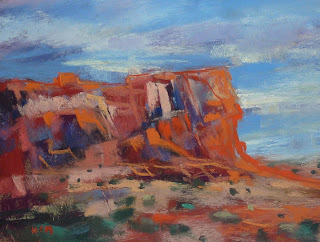 |
| 'Clouds, Beautiful Clouds' 13x18 pastel ©Karen Margulis |
Clouds are so commonplace that their beauty is often overlooked. They are for dreamers and their contemplation benefits the soul.
from the Manifesto of the Cloud Appreciation Society
I happen to enjoy painting clouds. I find that artists either love to paint them or avoid them. Often times students will get frustrated because their clouds look fake. You know, like white cotton balls pasted onto a blue sky. They give up on putting clouds in their paintings and thus the cycle begins.
There is a good reason why we often paint child-like clouds. It happens when we aren't really looking at the clouds. We allow our thinking brains to step in and tell us what a cloud looks like. And our thinking brain will usually give us the symbol we have for a cloud....the typical white scalloped shape.
But clouds are never that regular looking and they usually aren't pure white. Look carefully.
- The first step in painting better clouds is to become a better observer of clouds. Go outside or look out the window and watch the clouds. See them change shape and color. See their infinite variety. Look up and see how those white puffy clouds are brighter and whiter directly overhead. See how they tend to get smaller and stacked closer together as they move toward the horizon. Look at the edges of clouds. Are they ragged? Are they darker? Are the clouds thin and wispy or dense and puffy?
- Paint cloud studies. Don't worry about making a painting. Just paint the clouds you see. Paint them quickly.
- Paint clouds in your mind. Look at the clouds and if you don't have your pastels then imagine how you would paint them. What colors would you use?
- Read more about painting clouds. A great resource is John Carlson's Guide to Landscape Painting.
Appreciate the clouds. Don't take them for granted. They are just as beautiful as any feature in the landscape and all you have to do is look up.
Did you know that there is even a Cloud Appreciation Society? Have a look at their website and coming soon they will have a CloudSpotter App.

















































